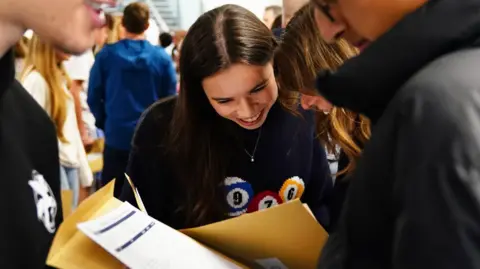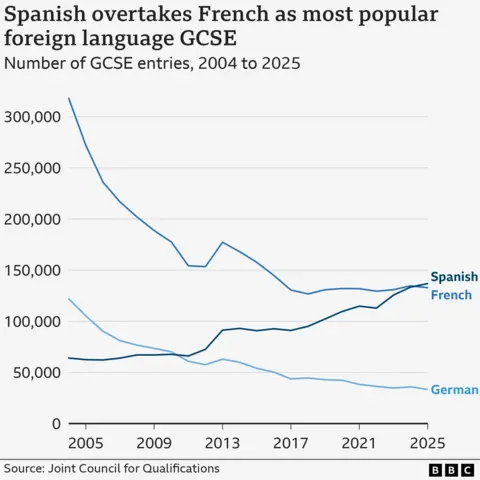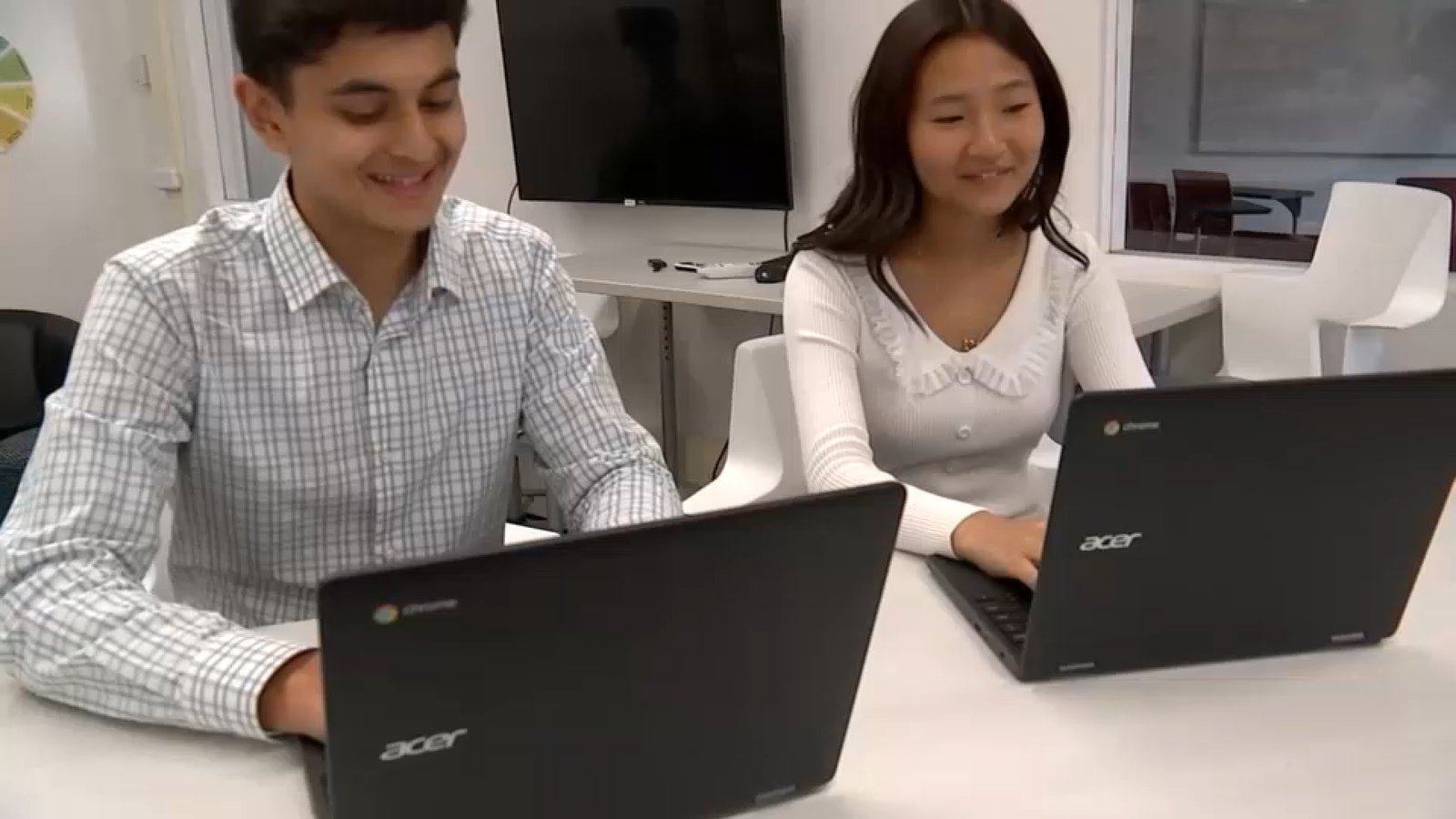Education
Is there a ‘resit crisis’? Key takeaways from 2025’s GCSE results

BBC Verify
 PA
PAMore than 600,000 teenagers have been opening GCSE and other Level 2 results on Thursday.
Most have just finished Year 11, marking the end of a secondary school journey that began in Covid “bubbles” back in 2020.
But a growing proportion of those opening results are older, having resat the English or maths GCSEs that they didn’t pass the first time around.
Many of those older students will have sat their initial GCSEs at a time when grades were being purposefully lowered to tackle grade inflation during the pandemic.
Here are the key things you need to know.
1. GCSE pass rate falls again
The GCSE pass rate has fallen again – with 67.4% of all grades in England, Wales and Northern Ireland at 4/C and above.
That is slightly down from 67.6% last year.
Grades were always expected to be similar to last year, after years of flux because of the Covid pandemic.
There were sharp rises in top grades in 2020 and 2021 when exams were cancelled and results were based on teachers’ assessments.
That was followed by a phased effort to bring them back down to 2019 levels, and grading returned to pre-pandemic standards across all three nations last year.
While the overall pass rate fell this year, there are differences between the nations.
England is the only nation to have seen a fall (from 67.4% to 67.1%). The pass rate has actually gone up in Wales (from 62.2% to 62.5%) and Northern Ireland (from 82.7% to 83.5%).
The percentage of all top grades, marked at 7/A or above, rose very slightly from 21.8% to 21.9%. There have been warnings of fiercer competition for places at sixth form colleges this year.

2. Resit numbers are up
Nearly a quarter of maths and English GCSEs were taken by people aged 17 and older this year.
They made up 23.4% of maths and English grades – compared to 20.9% last year.
Some will be mature students sitting exams for the first time, but most will be young people resitting papers.
Many of them will have taken their GCSEs the first time around when grades were being brought down after the pandemic, leading to fewer passes.
In England, pupils who don’t get at least a grade 4 in GCSE English and maths have to continue studying for it alongside their next course – their A-levels or their T-level, for example.
The Department for Education (DfE) says pupils should retake the exam when they think they are ready – although it has been described as a requirement in the past.
The pass rate for those who resit is far lower than it is for Year 11s.
In England, just 20.9% of English entries and 17.1% of maths entries from people aged 17 and over were marked at grade 4 or higher.
Jill Duffy, the head of the OCR exam board, said there was a “resit crisis”.
“Tinkering at the edges of policy won’t fix this,” she said. “We need fundamental reform to maths and English secondary education… to support those who fall behind.”
The Association of School and College Leaders called the policy “demoralising”, while the Association of Colleges said resits “can undermine confidence and motivation”.
They are all waiting for the DfE to publish its curriculum and assessment review this year, which is examining the policy.

3. Regional gap shrinks, but it’s still higher than before Covid
Education Secretary Bridget Phillipson warned on Wednesday that these GCSE results would “expose the inequalities that are entrenched in our education system”.
We only have limited data at the moment – a breakdown of exam results by things like ethnicity and free school meal status come later in the year – but we can look at regional differences.
Like last year, London had the highest pass rate (71.6%) and the West Midlands had the lowest (62.9%).
It’s the first time the gap between the highest- and lowest-performing regions has shrunk since 2021. It’s 8.7 percentage points this year, down from 9.4 last year.
However, the gap is still wider than it was at any point in the decade leading up to the pandemic, when it ranged between 6.4 and 7.2 percentage points.
The narrowing of the gap this year is not because the pass rate in the West Midlands has risen (it has actually dropped slightly), but rather because it fell more steeply in London than in any other region.

4. Gap between boys and girls is the lowest on record
The gap between boys’ and girls’ pass rates across all three nations has narrowed to its lowest on record.
Girls continue to outperform boys, but their grades have dropped while boys’ have risen slightly.
It means there’s a difference of 6.1 percentage points this year, down from 6.7 last year.
We’ve been looking over data that goes back all the way to 2000, and that gap is the lowest it’s been at any point this century.
It was at its widest in 2017 (9.5 percentage points) and has been falling ever since.
Analysis from the Education Policy Institute suggests that girls’ performance has been “declining in absolute terms” since the Covid pandemic.
It has linked this to “worrying trends around girls’ wellbeing” such as worsening mental health and social media use.

5. Au revoir French… hola Spanish
French has been a staple of British secondary education for years, but it’s been overtaken by Spanish in popularity for the first time ever.
There were 136,871 entries for Spanish GCSE this year, compared to 132,808 for French.
Ms Duffy, from the OCR, said it could be because Spanish was a “massive global language” and Spain was a popular holiday destination.
One French teacher at a school in Scarborough agreed, telling the BBC that pupils associated Spanish with their favourite footballers, as well as “sunshine and holidays”.
“They say they are more likely to use it when they go away,” she said.
The Association of School and College Leaders said it was “great to see” Spanish becoming so popular, but the decline in entries to French and German was a “source of concern”.

Additional reporting by Phil Leake, Libby Rogers, Muskeen Liddar, Daniel Wainwright and Jess Carr.
Education
Trump admin illegally froze Harvard funds, Judge says : NPR

Students walk up the steps of the Harry Elkins Widener Memorial Library on the campus of Harvard University.
Elissa Nadworny/NPR
hide caption
toggle caption
Elissa Nadworny/NPR
A federal judge in Boston handed Harvard University a legal victory on Wednesday. It’s the latest in a high-profile legal fight over whether the Trump administration acted illegally when it froze more than $2.2 billion in Harvard research funding in response to allegations of campus antisemitism.
In her ruling, Judge Allison D. Burroughs said the administration’s funding freeze was issued without considering any of the steps Harvard had already taken to address the issue.
Burroughs said she found it “difficult to conclude anything other than that [the Trump administration] used antisemitism as a smokescreen for a targeted, ideologically-motivated assault on this country’s premier universities, and did so in a way that runs afoul of [federal law].”
White House spokesperson Liz Huston said after the ruling: “We will immediately move to appeal this egregious decision, and we are confident we will ultimately prevail in our efforts to hold Harvard accountable.”
The more than $2 billion in federal funding that the administration had frozen supported more than 900 research projects at Harvard and its affiliates. That includes research into the treatment and/or prevention of Alzheimer’s, various cancers, heart disease, Lou Gehrig’s disease and autism. Burroughs also highlighted a program through the Department of Veterans Affairs “to help V.A. emergency room physicians decide whether suicidal veterans should be hospitalized.”
The case has been the subject of intense focus as Harvard has stood largely alone in pushing back against the Trump administration’s efforts to use funding cuts as leverage to win vast ideological and financial concessions from other elite institutions, including Columbia and Brown University.
In a July hearing, a lawyer for the Trump administration said Harvard’s funding had been frozen because the school had violated Title VI of the Civil Rights Act, which prohibits discrimination based on race, color and national origin, by failing to address antisemitism on campus.
But Burroughs ruled that it was the administration that had run afoul of Title VI by quickly freezing funding without first following a process clearly laid out in law.
Harvard’s attorneys had argued that the cuts imposed by the Trump Administration threatened vital research in medicine, science and technology.
Burroughs wrote in her decision that, “research that has been frozen could save lives, money, or the environment, to name a few. And the research was frozen without any sort of investigation into whether particular labs were engaging in antisemitic behavior, were employing Jews, were run by Jewish scientists, or were investigating issues or diseases particularly pertinent to Jews (such as, for example, Tay-Sachs disease), meaning that the funding freezes could and likely will harm the very people Defendants professed to be protecting.”
Burroughs underlined that antisemitism is intolerable, and criticized Harvard, saying it “has been plagued by antisemitism in recent years and could (and should) have done a better job of dealing with the issue.” But, the judge concluded, “there is, in reality, little connection between the research affected by the grant terminations and antisemitism.”
President Trump has previously been outspoken in his criticism of Burroughs, writing on Truth Social earlier this year that she is a “Trump-hating Judge,” and “a TOTAL DISASTER.”
Following Wednesday’s ruling, White House spokesperson Liz Huston again criticized Burroughs and said “It is clear that Harvard University failed to protect their students from harassment and allowed discrimination to plague their campus for years. Harvard does not have a constitutional right to taxpayer dollars and remains ineligible for grants in the future.”
“This ruling is huge. It is a big, decisive victory for academic freedom,” said Harvard history professor Kirsten Weld, who is also president of the Harvard chapter of the American Association of University Professors, which was a plaintiff in the lawsuit.
Even though the White House plans to appeal, Weld says she hopes this ruling sends the message “that you cannot break universities in this fashion and that it is worth standing up and fighting back.”
Education
Google Advances AI Image Generation with Multi-Modal Capabilities — Campus Technology
Google Advances AI Image Generation with Multi-Modal Capabilities
Google has introduced Gemini 2.5 Flash Image, marking a significant advancement in artificial intelligence systems that can understand and manipulate visual content through natural language processing.
The AI model represents progress in multi-modal machine learning, combining text comprehension with image generation and editing capabilities. Unlike previous systems focused primarily on creating images from text descriptions, Gemini 2.5 Flash Image can analyze existing images and perform precise modifications based on conversational instructions.
Technical improvements include enhanced character consistency across multiple image generations, a persistent challenge in AI image synthesis. The system can maintain the appearance of specific subjects while placing them in different environments or contexts, indicating advances in computer vision and generative modeling.
The model leverages Google’s large language model knowledge base, allowing it to incorporate real-world understanding into visual tasks. This integration demonstrates progress toward more sophisticated AI agents capable of reasoning across different data types.
Google implemented safety measures, including automated content filtering and mandatory digital watermarking through its SynthID technology. The watermarking addresses growing concerns about the identification of AI-generated content as synthetic media becomes more prevalent.
The launch intensifies competition in generative AI, where companies including OpenAI, Adobe, and Midjourney are developing similar multimodal capabilities. Industry analysts view image generation as a key battleground for AI companies seeking to expand beyond text-based applications.
Gemini 2.5 Flash Image is priced at $30 per million tokens. For more information, visit the Google site.
About the Author
John K. Waters is the editor in chief of a number of Converge360.com sites, with a focus on high-end development, AI and future tech. He’s been writing about cutting-edge technologies and culture of Silicon Valley for more than two decades, and he’s written more than a dozen books. He also co-scripted the documentary film Silicon Valley: A 100 Year Renaissance, which aired on PBS. He can be reached at [email protected].
Education
AI in schools: Pros and cons of artificial intlligence in education

SYOSSET, New York (WABC) — Days before school returns, hundreds of teachers on Long Island listened and learned.
“We’re excited to be here to share some of the initial work that we were able to do with AI at the time of this pilot,” teacher Tyler Gentilcore said.
Gentilcore was among dozens of educators with the Syosset School District sharing their approach to teaching artificial intelligence in the classroom.
“It feels pretty cool to be on the forefront of something new like this,” he said.
Gentilcore teaches first grade at Robbins Lane Elementary School.
“They’re little so the pilot was really an opportunity for teachers to engage with different AI programs,” he explained.
Programs like Google’s Gemini are now being used by teachers in the classroom, including Syosset High School English teacher Caroline Polatsidis.
“It was just scary because I was worried that students wouldn’t be learning anymore, that they would be letting AI do the work for them, but now I see that we need to harness this great power,” Polatsidis said.
What about cheating? A recent study by the Pew Research Center found that a quarter of teenagers nationwide have used the app ChatGPT for schoolwork.
Most felt it was wrong to use the advanced AI to write essays and solve math problems.
“I actually think people here in this high school use AI to help them with their assignments, but in ways that our teachers actually condone,” NiKhil Shah, Syossett High School senior, said.
“We don’t have any other choice but to do it now. AI is moving at a pace. The world is moving at a pace faster frankly than we can educate our kids,” Syosset Schools Assistant Superintendent David Steinberg said.
It’s not just the teachers who are embracing using AI in the classroom. Many students are too.
“I really started to understand AI in high school as some of my teachers introduced it to me and kind of started to guide us on how to use AI,” Shah explained.
Shah said using AI in school was introduced last year in his Spanish class.
“We would record speaking in Spanish. In order to improve the way we spoke, we would submit it to AI. It would analyze it and show us where we made mistakes, where we could improve,” he said.
Some students are skeptical.
“Personally, I never really was a fan of AI just because of the environmental costs it has,” senior Janice Opal Kang said.
According to the United Nations, the growing number of data centers that house AI servers use massive amounts of electricity, spurring the emission of global warming greenhouse gases.
Back in the classroom, AI is not only transitioning in schools on Long Island. Teachers at St. Benedict’s Prep Catholic School in Newark, New Jersey, are navigating the new world, too.
“It’s really forcing us to reevaluate what it is that we’re teaching and how we’re assessing what kids have learned. It’s really a pretty transformational thing,” teacher Trevor Shaw said.
* Get Eyewitness News Delivered
* Download the abc7NY app for breaking news alerts
Submit a tip or story idea to Eyewitness News
Have a breaking news tip or an idea for a story we should cover? Send it to Eyewitness News using the form below. If attaching a video or photo, terms of use apply.
Copyright © 2025 WABC-TV. All Rights Reserved.
-

 Business5 days ago
Business5 days agoThe Guardian view on Trump and the Fed: independence is no substitute for accountability | Editorial
-
Tools & Platforms3 weeks ago
Building Trust in Military AI Starts with Opening the Black Box – War on the Rocks
-

 Ethics & Policy1 month ago
Ethics & Policy1 month agoSDAIA Supports Saudi Arabia’s Leadership in Shaping Global AI Ethics, Policy, and Research – وكالة الأنباء السعودية
-

 Events & Conferences4 months ago
Events & Conferences4 months agoJourney to 1000 models: Scaling Instagram’s recommendation system
-

 Jobs & Careers2 months ago
Jobs & Careers2 months agoMumbai-based Perplexity Alternative Has 60k+ Users Without Funding
-

 Education2 months ago
Education2 months agoVEX Robotics launches AI-powered classroom robotics system
-

 Funding & Business2 months ago
Funding & Business2 months agoKayak and Expedia race to build AI travel agents that turn social posts into itineraries
-

 Podcasts & Talks2 months ago
Podcasts & Talks2 months agoHappy 4th of July! 🎆 Made with Veo 3 in Gemini
-

 Podcasts & Talks2 months ago
Podcasts & Talks2 months agoOpenAI 🤝 @teamganassi
-

 Education2 months ago
Education2 months agoMacron says UK and France have duty to tackle illegal migration ‘with humanity, solidarity and firmness’ – UK politics live | Politics


